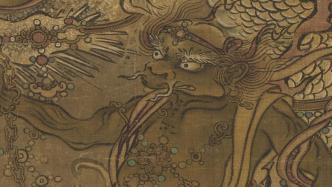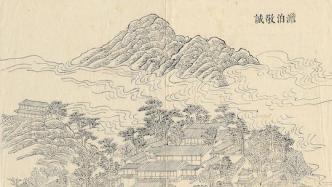
The Summer Resort, also known as Rehe Palace and Luanyang Palace, was built in the 42nd year of Kangxi (1703). It is not only the most extensive of the royal gardens in the Qing Dynasty, but also the most well-preserved royal palace at present.
"A Village Chronicle, Half of the History of the Qing Dynasty". The Paper learned that on September 24, "The Mountain Resort - Epitome of the Qing Empire's Rule" was exhibited at the northern campus of the National Palace Museum in Taipei. The exhibition is divided into six units, including "Managing a Garden as Governing a Country: The Great Qing Empire in a Micro Universe", "Diversity of Ruler Identity", and "Politics and Etiquette". Introduction, one by one to present the special significance of the Qing Dynasty summer resort.

Poster for the exhibition "Summer Resort - Epitome of Qing Empire's Rule"
The construction of the villa, as the name suggests, is a summer resort that the emperor goes to every year, but its significance is not limited to this. Because the Jehol area where the villa is located, is mostly Mongolian nomadic land, which belongs to the frontier land of the Qing Empire facing North Asia. Every year from May to September, the emperors of the Qing Dynasty stayed at the villa to escape the summer heat, hunted in autumn, and received living Buddhas of Mongolia and Tibet, princes and nobles, and foreign envoys also visited the villa because of the emperor's residence. The emperor's decree was implemented when he was stationed in Shanzhuang. The status of the Mountain Resort in the Qing Empire has undoubtedly become the second political center outside the Forbidden City.
With the increasingly important status of the villa, the emperor of the Qing Dynasty has gone through several generations of careful management, the expansion of the administrative area where he is located, the construction of the palace along the way, the planning of the landscape layout of the villa, the design of the gates and pavilions, and even the management of officials in the paddock. It reflects the diverse and diverse characteristics of the Qing Empire's rule of Manchu, Mongolian and Han political systems, inland and frontier cultures, Tibetan Buddhism and Central Plains beliefs and religions. Therefore, in this exhibition, the National Palace Museum in Taipei presents the theme of "Managing a Garden as Governing a Country: The Great Qing Empire in a Microcosm", "Diversity of Rulers' Identity", "Multiple Religious Policy", "Multiple Characteristics of Local Political Systems", "Diversity of Languages and Characters" And the six units of "Politics and Etiquette", selected representative calligraphy, painting, utensils, cultural relics and related archives and documents in its collection, and presented the special significance of the Qing Dynasty summer resort one by one through the introduction of pictures and texts.
Administering a garden is like administering a country: the Qing Empire in a microcosm
As the second political center of the Qing Empire, the summer resort, from its architectural regulations and layout, can be found in a similar pattern to the capital Beijing; and by imitating the various scenic spots in the empire or the way of transplanting properties, it highlights the diverse gathering of the villa in the royal gardens features.
The Mountain Resort and surrounding buildings can be roughly divided into palace area, lake area, plain area and temple area. The palace area is where the emperor manages affairs, holds celebrations and rests. The axis of the building is completely in accordance with the pattern of the Forbidden City. The lake area is where the emperor rested and entertained. One of them has the characteristics of the villa itself, and some are built to imitate the famous scenic spots in the south of the Yangtze River. The same plants and trees include both native products of Saibei and species transplanted from various places in the customs. The plain area is centered on the Wanshu Garden, where huge yurts are raised. The emperor graciously received Mongolian princes from foreign vassals or foreign envoys from various states who came to the dynasty. It was an important diplomatic venue for the Qing Empire. As for the surrounding area of the villa, there are temple areas specially built by the Kangxi and Qianlong dynasties to commemorate important celebrations in the Han-Tibetan style, commonly known as the "Eight Outer Temples".
From construction to design, the summer resort integrates imperial rule, cultural transfer, diplomatic etiquette, military and religion in one garden, just like a miniature universe of the Qing Empire. The first unit of the exhibition describes the structure of this small universe with documents and paintings collected by the National Palace Museum in Taipei.
"The Story of the Mountain Resort" is an important document that provides us with an understanding of the historical development of the mountain resort from the "Rehe Palace" to the mountain resort. The full text was written in the late June of the 50th year of Emperor Kangxi (1711), when Emperor Kangxi changed the name of "Rehe Palace" to "Summer Resort". In the article, Emperor Kangxi explained that the reason why he chose Rehe as his palace was that the road was close to the capital, and it took only two days to go back and forth. The geographical scenery of the river can enable the emperor to gain insight into the people's livelihood and crops, and the feelings of the people.

Picture of Lizheng Gate Included in Volume 30 of Imperial Rehe Chronicles, compiled by Emperor Heshen and others in the Qing Dynasty, published in Wuying Hall in the 46th year of Emperor Qianlong's reign in the Qing Dynasty

Lizhengmen
The main entrance of the Mountain Resort, "Lizhengmen", is the first door to enter the main hall of the palace area. The gate was built in the nineteenth year of Qianlong's reign (1754) in the Qing Dynasty. The three characters "Lizhengmen" in Chinese inscribed by Emperor Qianlong's imperial inscription are engraved on the top of the gate. "Lizheng", the Chinese text is taken from the "Book of Changes", "the sun and the moon are as beautiful as the sky, the grains and trees are as beautiful as the earth, and the Ming Dynasty is as beautiful as the earth. (Clarity) city gate", the meaning is more simple and simple. The five styles of the city gate reflect the characteristics of the multi-ethnic language and culture under the rule of the Qing Empire.
The palace area of the Mountain Resort is located in the southern part of the villa, where the emperors of the Qing Dynasty were stationed in the villa to handle political affairs, hold celebrations and sleep. It consists of four parts: the main palace, the east palace, Wanhe Songfeng and Songhezhai. The architectural specifications of the main palace are built according to the layout of the front and the rear of the central axis of the Forbidden City in Beijing, which is symmetrical, regular and solemn. The former dynasty is represented by the Danbo Jingcheng Hall, and the latter is represented by the Yanbo Zhishuang Hall. In the middle and late Qing Dynasty, the two emperors Jiaqing and Xianfeng died in the villa successively, and the national situation began to slowly enter the sunset.

Danbo Jingcheng Hall Map Included in the "Jinding Rehe Zhi" Volume 35, Qing Heshen and others were ordered to compile the Qing Dynasty, the forty-sixth year of Qianlong Wuying Hall
Danbo Jingcheng Hall is the main hall of the main palace in the palace area. It is the place for the Qing Dynasty emperor to handle the affairs of the government and hold major celebrations in Shanzhuang. Its role is similar to that of Beijing Taihe Hall. It was first built in the 50th year of Emperor Kangxi (1710), and the four characters "Danbo Jingcheng" are hung in the center of the hall. In the nineteenth year of Qianlong's reign (1754), the ceiling, lattice windows and inner and outer columns of the hall were all rebuilt with nanmu, so it was called "nanmu hall".
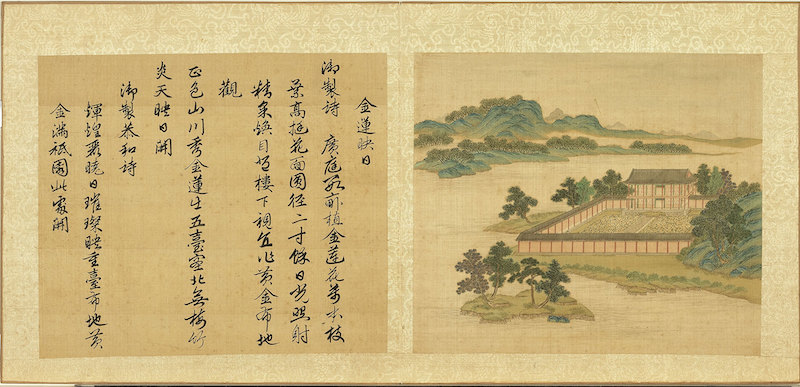
Yan Bo Zhishuang received "The Summer Resort and the Book of Poems Inscribed by Qianlong", Qing Zhang Ruoai's paintings during the Qianlong period
Located at the rear of the main hall area, it belongs to the residence of the emperor's bedroom. Built in the forty-ninth year of Kangxi (1710), Emperor Kangxi said that the place is "high and open, and the air is clear", "ten miles of Pinghu, so refreshing", so it was named "smoke waves to cool", and it was specially listed as a place. The first of the thirty-six scenic spots in the villa. In the middle and late Qing Dynasty, the national power was declining day by day, and two emperors, Jiaqing and Xianfeng, died in this palace one after another. Subsequently, the activities of the villa gradually turned quiet, and finally tended to decline.
The lake area of the villa is adjacent to the palace area and consists of nine large and small lakes. There are many islands in the lake, each with its own name, such as Wenyuan Island, Ruyizhou, Qinglian Island, Jinshan, Moonlight Jiangsheng Island, etc. The island and lake are connected by small bridges and long embankments, pavilions and pavilions, and shady trees. Not only some potted plants were transplanted from the mainland of the empire, but the buildings in the area also imitated the layout of gardens in the south of the Yangtze River. For example, the Yanyu Building on Qinglian Island is based on the Yanyu Building in Jiaxing, Zhejiang Province. The lion forest of Wenyuan is imitated from the lion forest in Suzhou, and the design of Jinshan Island is from Jinshan, Zhenjiang. The lake area was the place where the emperors and empresses of the Qing Dynasty stayed in the villa for a summer break. Emperors Kangxi and Qianlong also took thirty-six beautiful views from the villa and left many official publications and drawings.
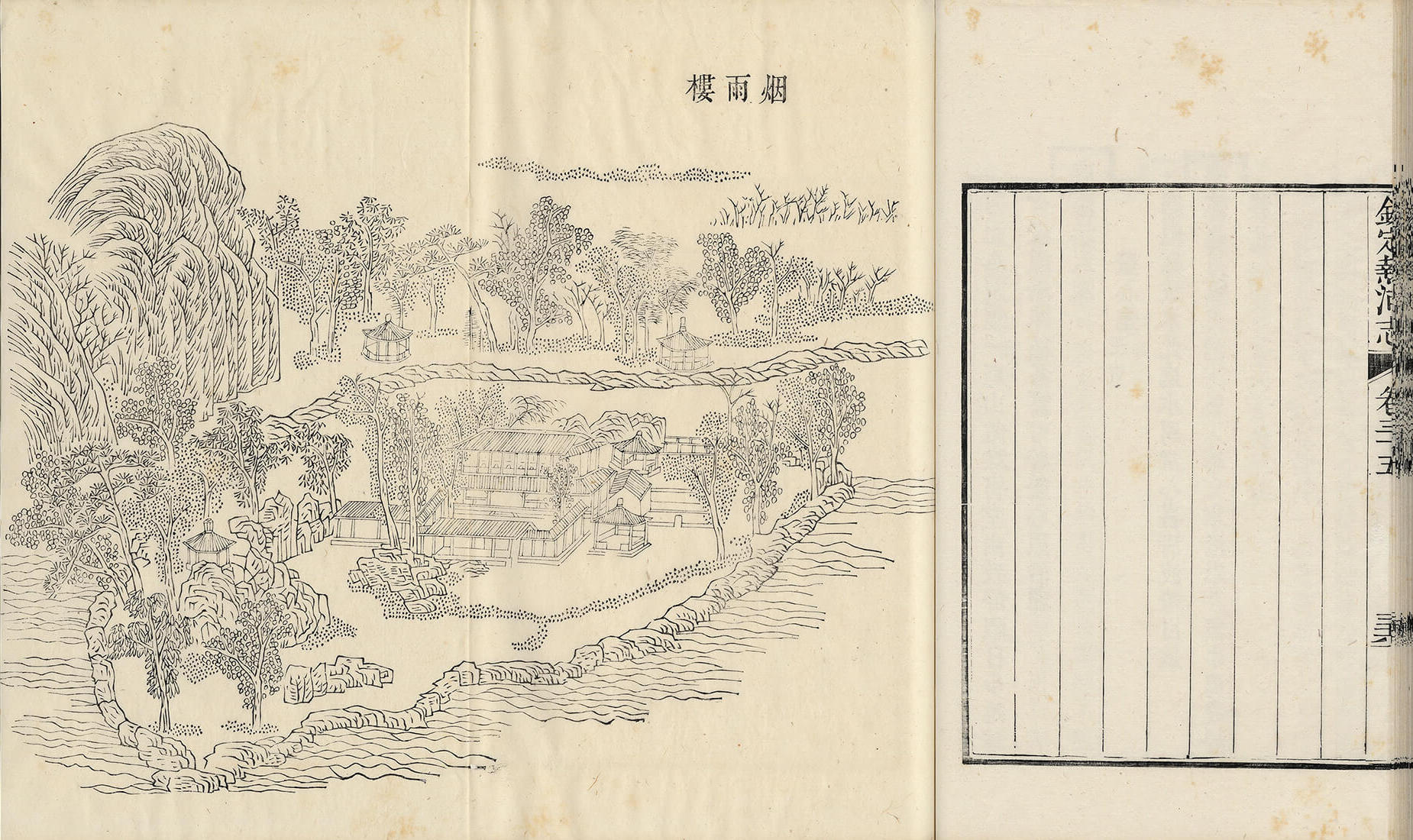
A map of Yanyu Tower Included in Volume 35 of the Imperial Records of Rehe, compiled by Heshen and others in the Qing Dynasty, published by Wuying Hall in the 46th year of Emperor Qianlong of the Qing Dynasty
Zhejiang Yanyu Building is a garden building complex located on the island in the center of the lake. Emperor Qianlong visited the Yanyu Building many times during his southern tour, and was delighted with the misty and rainy scenery by the lake in late spring. In the forty-fifth year of Qianlong (1780), after the fifth south tour, he ordered a copy of the building on Qinglian Island to the north of Ruyi Island in the Summer Resort according to the map of Yanyu Building in Zhejiang, and it was also named "Yanyu Building". Comparing the pictures of "Yanyu Tower" in "Southern Tour Grand Ceremony" and "Rehe Chronicles", although the two floors are slightly different, the layout is quite similar.
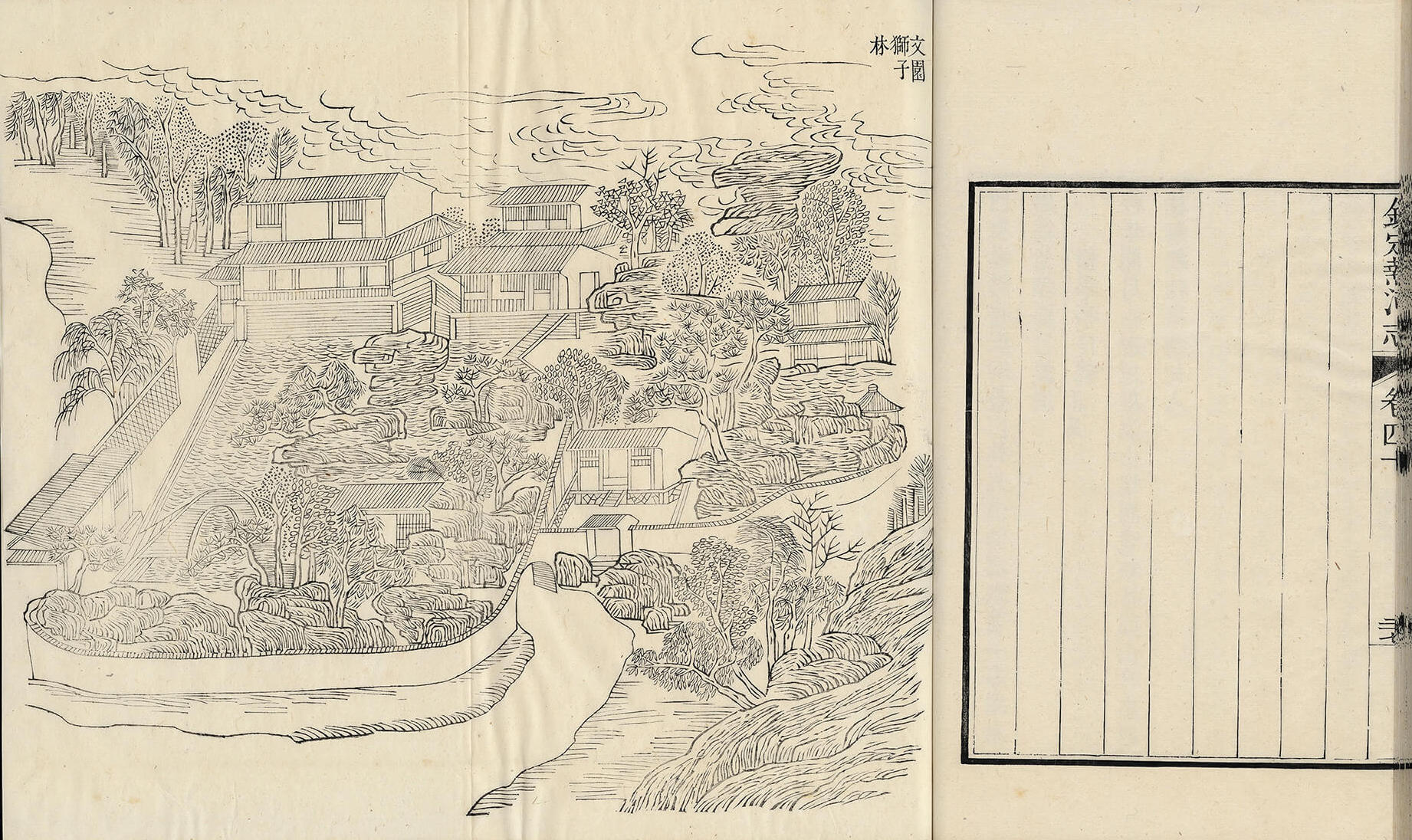
The lion forest map in the Wenyuan was included in the forty volume of "Jinding Rehe Zhi", compiled by Heshen and others in the Qing Dynasty.
Rehe Villa Wenyuan Lion Forest is located in the southeast of the Lake District of the Villa, in front of the Qingshu Mountain Pavilion. The strange stones are stacked in the garden, the rockery is rugged and undulating, and the construction is exquisite, which has the charm of the Suzhou Lion Forest painted by the painter Ni Zan (1301-1374) of the Yuan Dynasty. The name of the villa is Wenyuan Lion Forest, which is used to distinguish Wuzhong (Suzhou) Lion Forest from Beijing Yuyuan (Yuanmingyuan) Lion Forest.
The plain area is located in the northeast of the summer resort, and is divided into two parts. The western grassland is dominated by "testing horses", which was the site for the Qing emperor and Mongolian princes to test and select horses before hunting; the eastern woodland is "Wanshu Garden". As a representative, the park is full of large and small yurts, showing the scenery of northern Mongolian grasslands. During the Kangxi period, Wanshu Garden was used as a hunting place in the mountain village, but in the Qianlong period, it was expanded on a large scale, giving this area an important function in connecting foreign vassal Mongolian, Tibetan princes, religious leaders, and foreign envoys and diplomatic pilgrimage banquets.
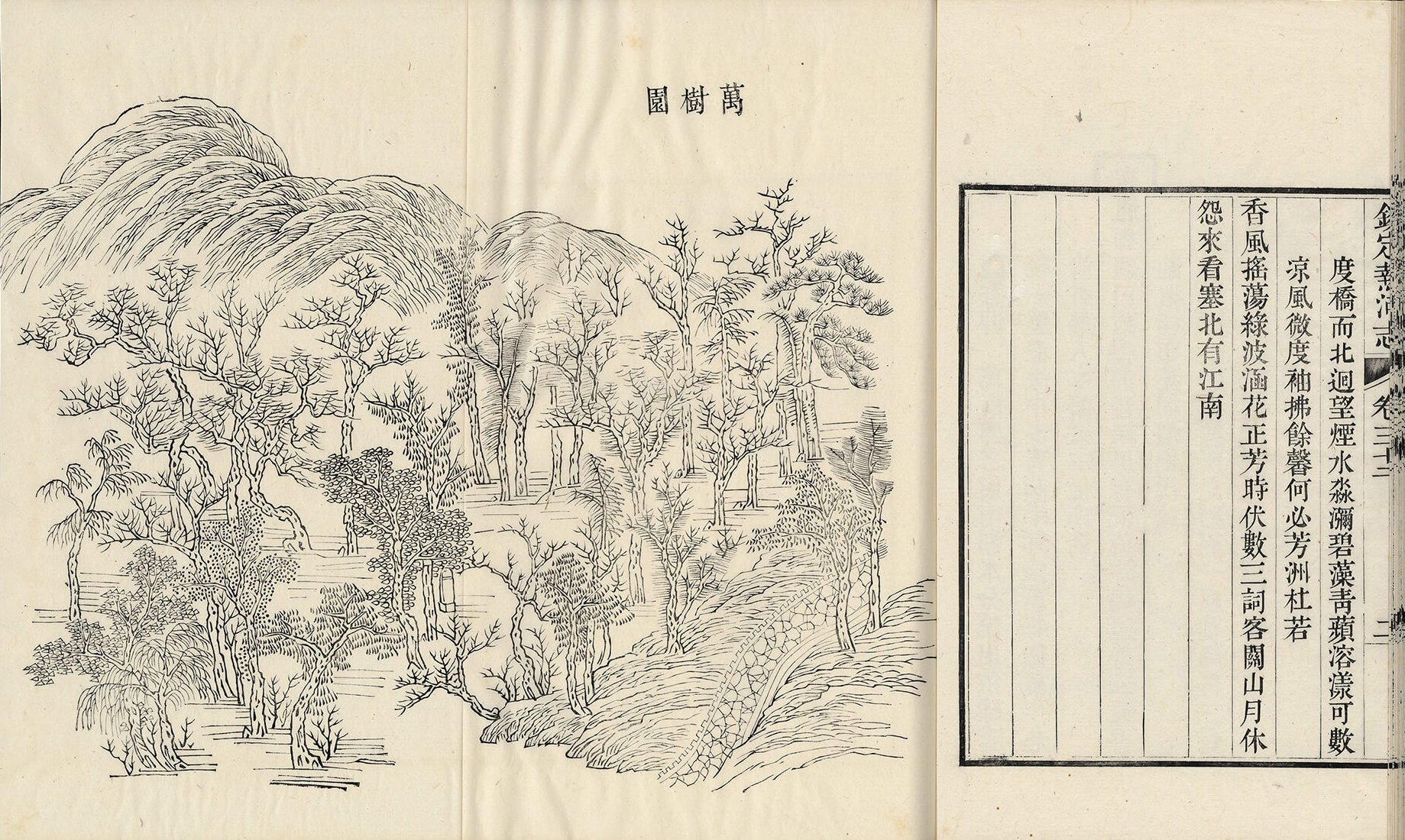
Map of Wanshu Garden Included in Volume 32 of Imperial Rehe Chronicles, compiled by Emperor Heshen and others in the Qing Dynasty, published in Wuying Hall in the 46th year of Emperor Qianlong's reign
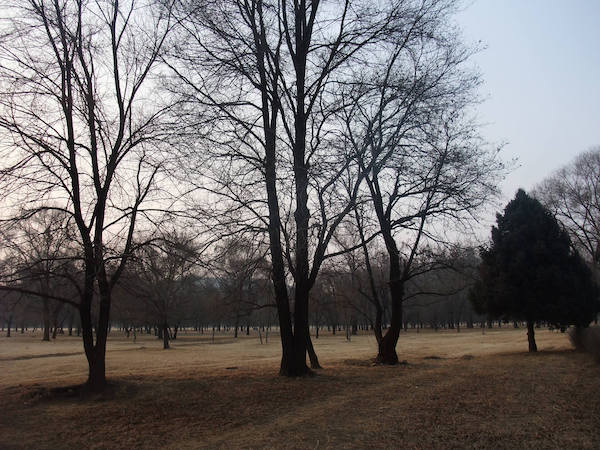
The real scene of Wanshu Garden
Wanshu Garden is located on the plain on the north side of the villa. During the Qing Dynasty, the garden was full of yurts of various sizes, presenting the scenery of Mongolian grassland. During the Kangxi period, this area was mainly used as a hunting place. Since the Qianlong period, it has gradually evolved into a banquet place for receiving Mongolian princes, nobles and foreign envoys. Emperor Qianlong's birthday coincided with the residence at the Mountain Villa. Wanshu Garden provided a banquet to celebrate the royal family ministers and Mongolian princes and nobles, and played an important diplomatic function in linking the friendship between the Qing Empire and the leaders of the frontier ethnic groups. The yurt banquets in Wanshu Garden are mostly held around the Mid-Autumn Festival. On the plain of the villa for several days, the Man City is surrounded and various Mongolian-style entertainment activities are held. Horse racing), Shibang (Mongolian music and dance), Jiaojia (horse taming) and Buku (sumo), as well as fireworks, acrobatics, singing and dancing, etc., present the scene of the prosperity of China and foreign countries during the Qing Dynasty.
Around the villa, from north to southeast, along the Shizigou to the hilly area on the east bank of the Wulie River, there are many temples in the Han and Tibetan styles. Among them, there are eight temples outside Gubeikou under the unified management of Beijing Lifan Institute, commonly known as the "Eight Outer Temples". "The most famous is a temple specially built by the Qing Empire to commemorate important events. The Qing Empire used religious belief to consolidate and strengthen the relationship with the Mongolian and Tibetan people who believed in Tibetan Buddhism, so as to achieve a political strategy of long-term peace and stability in the northern Xinjiang.
After the San Francisco Rebellion (1673-1681) was settled in the 20th year of Kangxi's reign, the Qing Empire began to shift its focus to strengthening security in the north. In order to guard against the threat of Russia and the Junggar Ministry of Moxi Mongolia, the Qing Empire adopted a diplomatic strategy to actively win over Monan and Mobei Mongolia, and consolidate the frontier defense through the marriage of Manchu and Mongolia. Emperor Kangxi believed that the traditional construction of the Great Wall in China only increased the burden on local people, but failed to ensure national defense security. Now, through the alliance with northern Mongolia and the award of titles, the border defense policy of consolidating the north and achieving long-term stability has been achieved. "The theory that the Great Wall is useless" is exactly the strategy of Emperor Kangxi to gather all the Mongolian ministries as Pingfan's border control strategy. The Rehe place and the summer resort are playing an important role in the imperial border strategy.
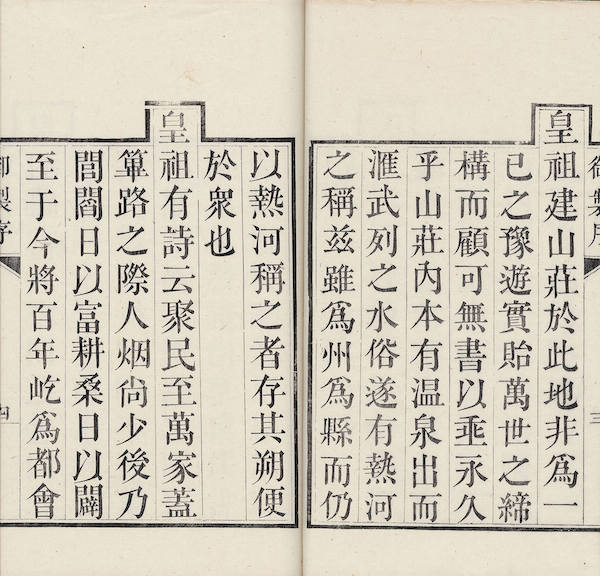
The preface to "Rehe Chronicles" made by Emperor Gaozong of the Qing Dynasty was included in the preface to "Jinding Rehe Chronicles".
"Rehe Zhi" is a very special local chronicle. Its special feature is that most local chronicles are compiled by local prefectures and counties, but the compilation of this book is the responsibility of important officials such as Heshen (1750-1799) and Liang Guozhi (1723-1786) appointed by the central government of the Qing Dynasty. This shows the importance of Rehe in the hearts of the Qing government.
The book was completed in the 45th year of Qianlong (1781), and the emperor specially wrote a preface. There are two reasons for the difficulty of writing a book, and there are two reasons why it is necessary to make a will for Rehe. Rehe is located in a remote area outside the customs, lacking historical data, the first difficulty is that most of the existing history is made by the Han people, and there is a lack of understanding of local customs and language customs. Since the establishment of Emperor Kangxi, more than 100 years have passed, and the population has become more and more popular; secondly, and more importantly, the emperor Kangxi operated Rehe and Summer Resort, not for personal summer vacations, but to prevent Mongolia, the deep meaning of strengthening the northern border defense. At the end of the preface, it is pointed out that the name Rehe is named after the confluence of the hot spring water in the villa and the Wulie River. This book continues to use place names to form a record of mountains and rivers.
From Diversity of Rulership to Diverse Religious Policies
The Mountain Resort was an important place for the rulers of the Qing Dynasty to deal with ethnic affairs. Facing the diverse ethnic groups inside and outside the empire, the Manchu rulers showed their multiple identities according to the different objects of their rule. As rulers of multi-ethnic empires, they sometimes called themselves emperor (hūwangdi) or son of heaven (abkai jui), and sometimes called themselves monarch or han (han). As the master of the Eight Banners, the Manchu ministers were called "ejen" when they gave their performances. In addition, the Manchu ruler has another identity - "Menshu Emperor" (jam yang gongma). This name is the custom of calling emperors from Tibet since the Shunzhi period of the Qing Dynasty. Emperor Qianlong (Hong li, reigned 1736-1795) even pretended to be the living incarnation of Manjushri, and created the image of "Emperor Manjushri" by drawing a series of images of himself. For example, the exhibition "The Completion of the Shuxiang Temple is a Celebration" is that Emperor Qianlong built the Shuxiang Temple, a temple with the same name at the foot of the Wutai Mountain, in the summer resort. match. Through the exhibition of cultural relics, you can see that the former halls and pavilions are slightly imitated from the Wutai Mountain Shuxiang Temple.
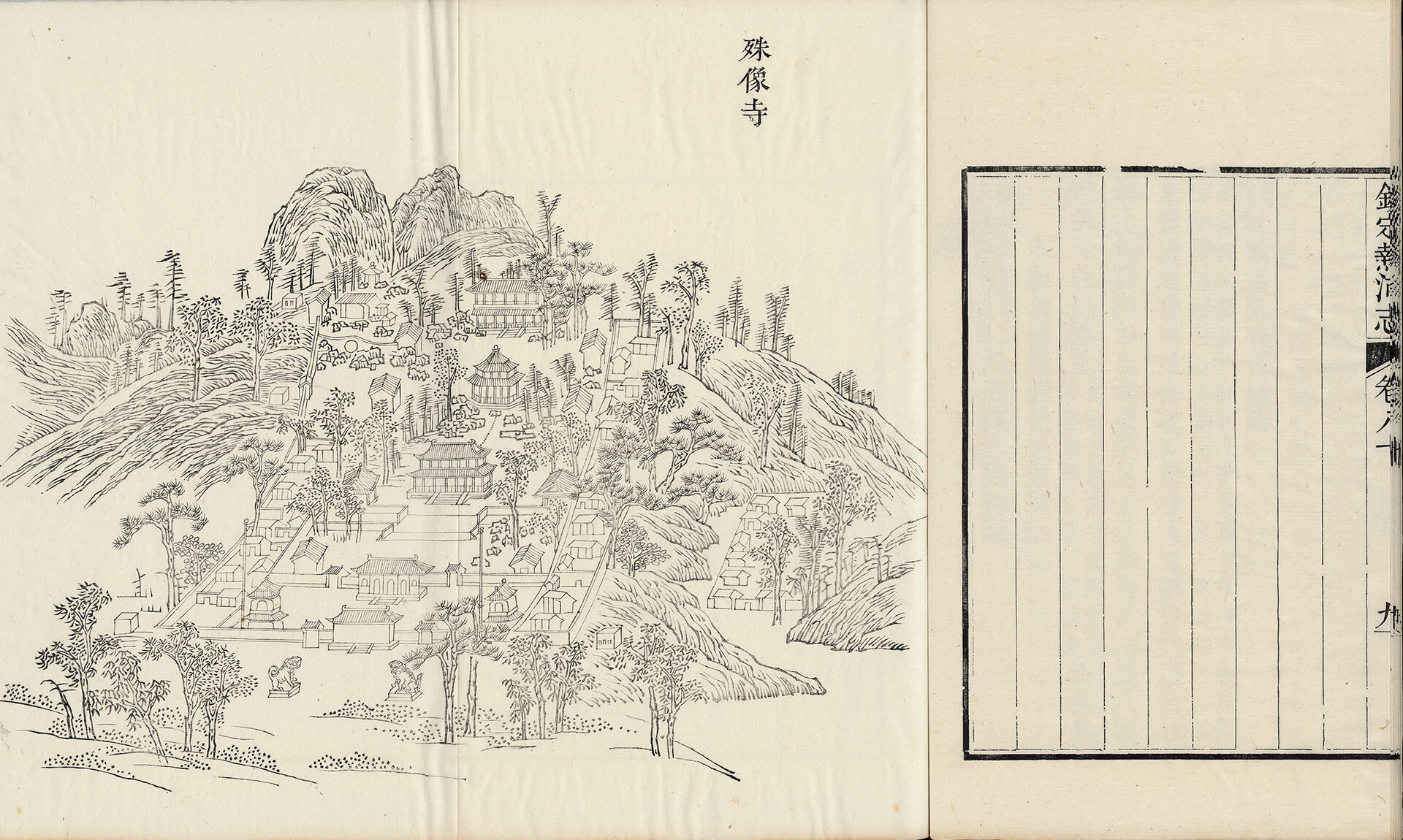
The completion of the Shuxiang Temple is a matter of fact, and it is included in the "Jinding Rehe Zhi" volume 80. Qing Heshen and others were ordered to compile the Wuying Hall in the forty-sixth year of Qianlong in the Qing Dynasty.
In the vast territory under the rule of the Qing Empire, there are many different ethnic cultures, so there are also quite a variety of various religious beliefs. The Manchus originally inherited the shamanic beliefs of the Jurchen outside the customs. In the early seventeenth century, they were influenced by the neighboring Mongolians and accepted Tibetan Buddhism as their main belief; The Gelug Sect (Yellow Sect), which is dominated by reincarnated eminent monks of the Lu Sect, became the common belief of the Manchus, Mongolians and Tibetans in the Qing Dynasty. Although the Qing emperor adopted Tibetan Buddhism as his belief, he did not forcefully promote this belief to other ethnic regions like the Mongolian emperor of the Yuan Dynasty. The Chinese Buddhism, Confucianism (the Confucian temple worshipping Confucianism), Taoism, and even the Islamic beliefs of the northwestern ethnic groups, which the Han people believe in, still have their own development space even under the policy management of the Qing court. Such religious features are also reflected in the history and furnishings of the Mountain Resort.
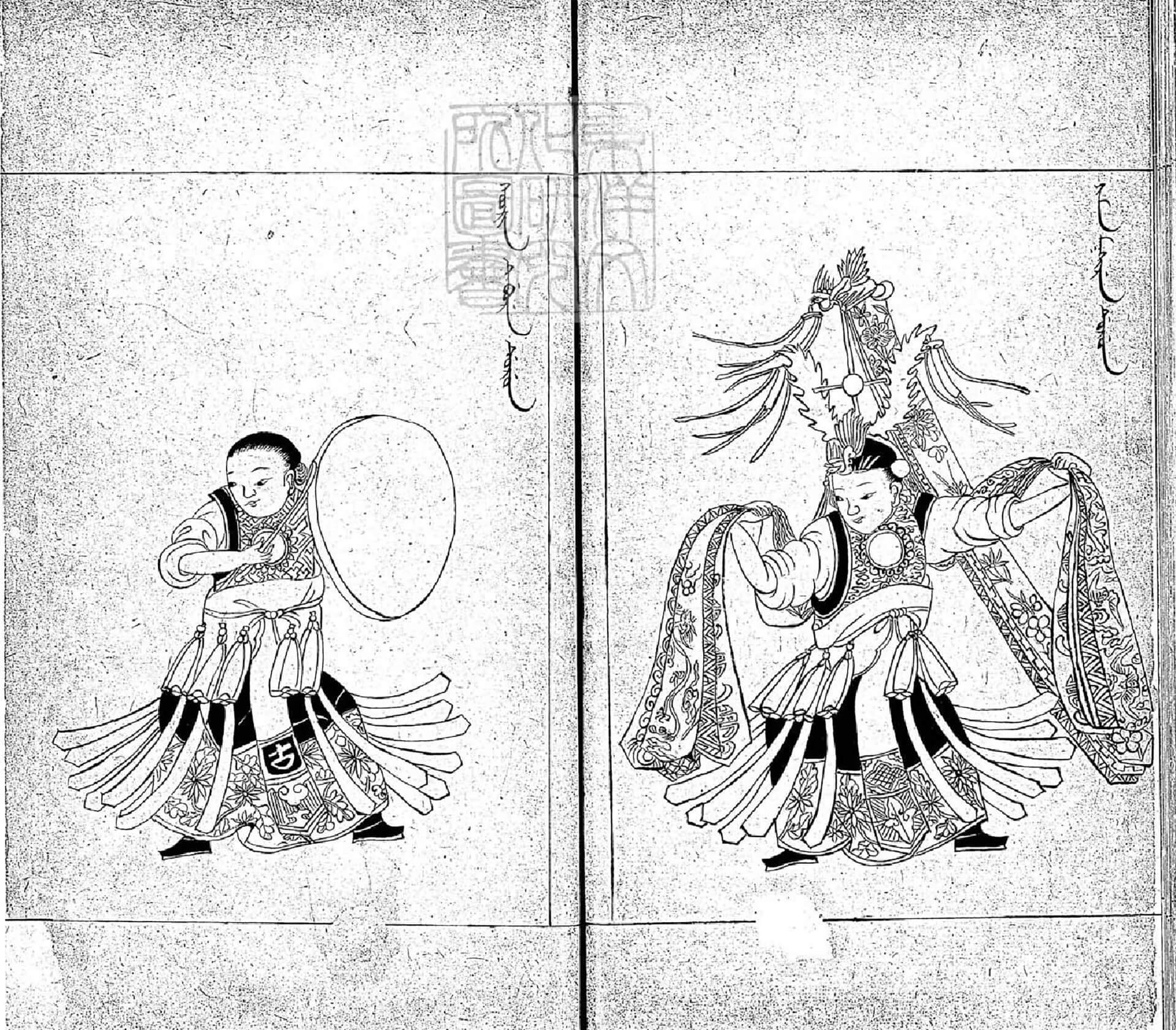
The Manchu ritual of worshiping gods and offerings to the heavens was included in Volume 89 of the Annals of the Imperial Eight Banners, written by Ji Yun and others in the Qing Dynasty, and published by Wuying Hall in the fourth year of Jiaqing in the Qing Dynasty (1799).
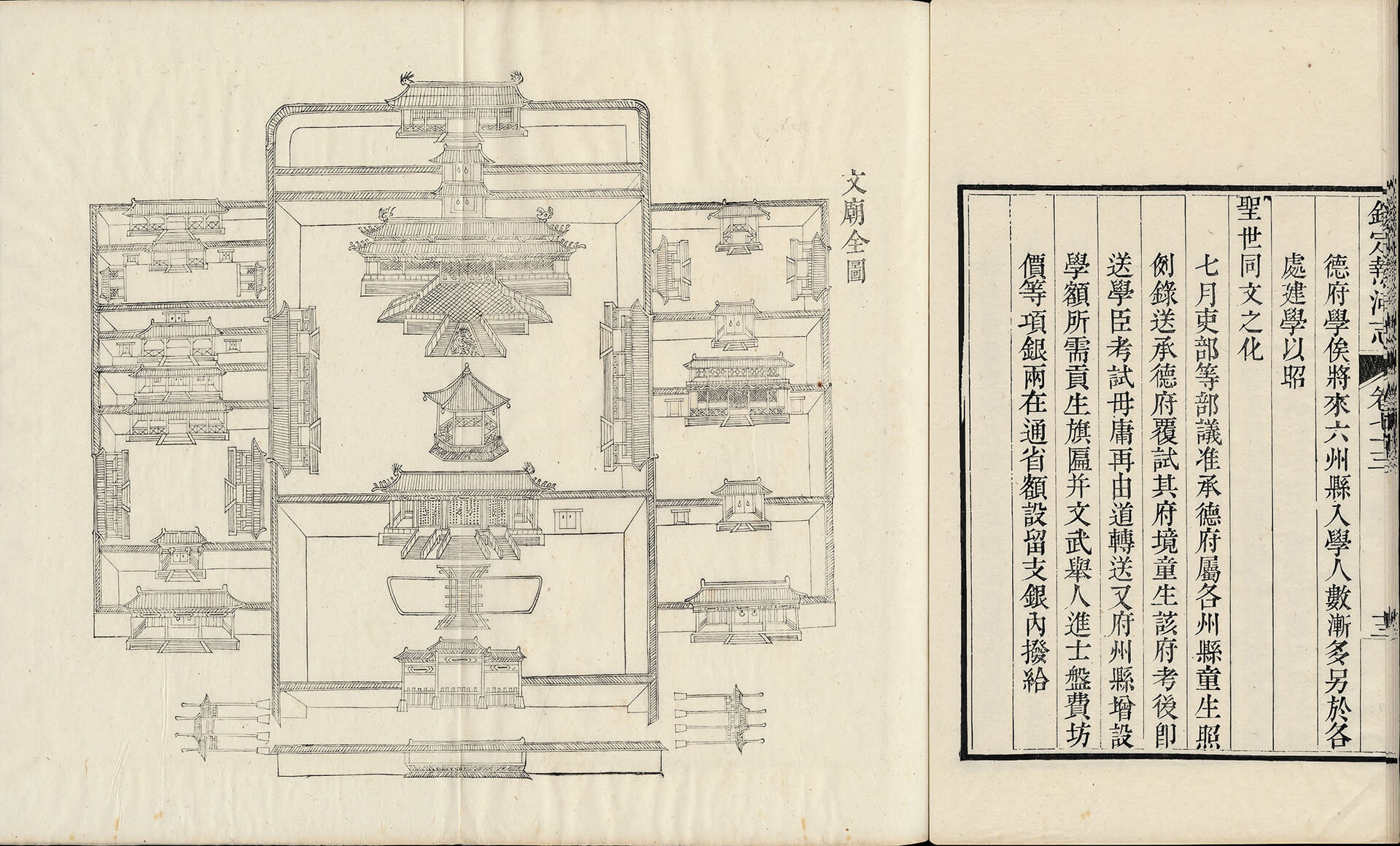
The map of the Confucian Temple in Rehe was included in the "Imperial Rehe Chronicles", Volume 73, published by the Emperor Heshen and others in the Wuying Hall of the Qing Dynasty in the 46th year of Emperor Qianlong's reign.
From the "Rehe Confucian Temple Map" exhibited this time, we can see the characteristics of this multi-faith. The Rehe Confucian Temple was built in the 44th year of Qianlong's reign (1779), and it is known as the three major Confucian temples in China together with Shandong and Beijing. It can be seen from the picture that the main entrance of the Confucian Temple has an east-west archway. The plaques of "Dachengmen" and "Dacheng Hall" are inscribed in Manchu, Mongolian and Han Chinese characters, marking the characteristics of the Rehe Confucian Temple area. As for the architectural regulations and interior furnishings, they all follow the specifications and standards of the Beijing Confucian Temple, reflecting the important position of the Rehe Confucian Temple in Emperor Qianlong's heart.
China under the Qing Dynasty was a multi-ethnic country with Manchus as the main body. In order to meet the needs of stable governance, the arrangement of the political system not only reflected the multi-ethnic system in the central government, but also reflected the multi-ethnic system at the local level according to local conditions. the appearance of domination.
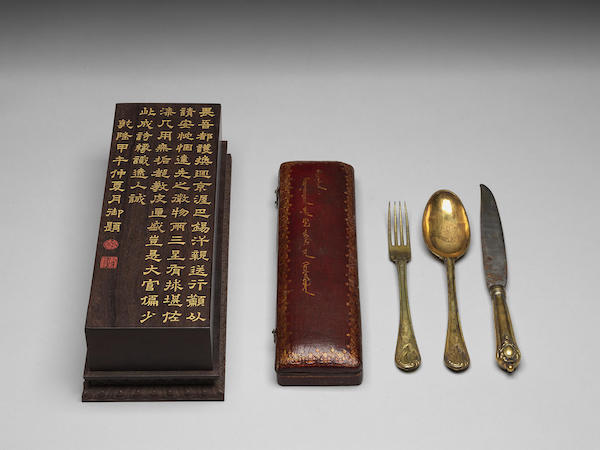
A gilt-bronze knife, fork and spoon, presented to Emperor Qianlong by Turghute Ubasi Khan (with brocade jacket, leather box and wooden box), 39th year of Qianlong, Qing Dynasty
In addition, in terms of politics and etiquette, the Mountain Resort was also the activity center for the Qing emperor to escape the summer and deal with military and political affairs every year. For example: in the 20th year of Qianlong (1755), Emperor Gaozong had a feast here for the four upper-class nobles of Erut Mongolia to celebrate the pacification of the rebellion of Dawaqi of the Dzungar tribe; in the 36th year of Qianlong (1771), he met and led the east in the mountain village. The returned Mongolian Turghut leader Ubasi; in the 45th year of Qianlong (1780), he received the sixth Panchen Lama who came from Shigatse, Tibet to celebrate his 70th birthday; and even in the fifty-eighth year of Qianlong (1793), he received the British Special Envoy Macartney. The Eight Outer Temples around the Rehe Palace were also built one after another in the process of the Qing court's stabilization of the north and west. Through religious buildings, they gathered the Mongolian and Tibetan ethnic groups and consolidated the Manchu-Mongolian alliance.
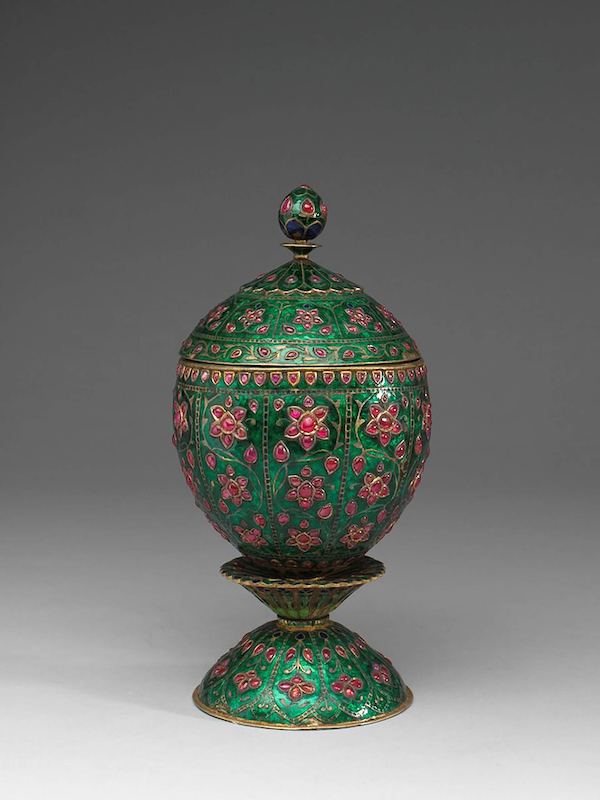
A gilt and silver jar filled with enamel and inlaid with a treasure lid (with a wooden leather box), 45th year of Qianlong, Qing Dynasty
The gilt and silver jars on display this time are filled with enamel and inlaid with treasures, which is a gift from the sixth Panchen Lama. On the 70th birthday of Emperor Gaozong in the 45th year of Qianlong (1780), the sixth Panchen Lama (1738-1780) went to Beijing to celebrate his birthday. In August of that year, the two met at the Summer Resort, and the sixth Panchen Lama presented many gifts to Qianlong. This "gilt and silver jar filled with enamel and inlaid treasure lid" was a gift when it was first seen on the second day of the eighth lunar month. However, the craftsmanship and decoration of this jar are not Tibetan cultural relics, but are works of the Mughal Dynasty in India. The 108 "Gabra Rosary Beads" are made of skulls. The sixth Panchen Lama dedicated it to the seventh day of the eighth lunar month, which is the auspicious day of Qianlong's 70th birthday.
"A Village Chronicle, Half of the History of the Qing Dynasty". In the prosperous Qing Dynasty, when the emperor and his entourage crossed the Great Wall, Mongolian princes from all over the northern part of the Saibei dispatched officers to greet each other on the road, forming a long queue to exchange greetings with each other. The Qing emperor's management of the villa actively attracted the leaders of Mongolia and Tibet to drive the prosperity of the Rehe area, showing the characteristics of the multi-cultural integration of the empire when all countries came to the dynasty.
It is reported that the exhibition will last until February 5, 2023.
(This article is based on the official website of the Taipei Palace Museum and related documents.)

